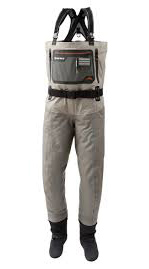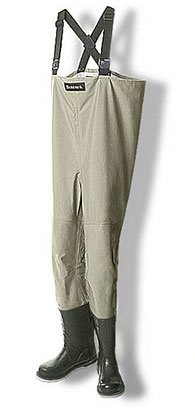Waders & Boots Buying Guide
1 June 2015 | Admin
Wader & Boots Buying Guide
For the angler venturing out to fishing rivers the right combination of waders and wading boots are an essential part of your fishing gear. With the appropriate waders and boots the angler is able to cover various fishing situations and access pools and lays that would otherwise be out of reach for the bankside angler. Standard waders will keep you dry and good quality breathable will keep you both cool and dry whilst standing up to the rigours of a hard seasons fishing. Suitably devoted wading boots will afford a secure grip underfoot when walking on the banks and wading through the water. Good quality wading boots will also provide a high degree of ankle support whilst at the same time offering maximum comfort and maximum performance.
Which are the best waders for me?
For the angler looking at purchasing a new pair of waders, the choice is often daunting. However, armed with a little prior knowledge any angler should feel comfortable in walking into any tackle shop and purchasing a suitable pair of waders. If we take out of the equation the various material types used in the manufacture of waders, it leaves us with a straightforward choice between Stockingfoot and Bootfoot designs. 
Stockingfoot waders Though they sound rather complicated, Stockingfoot waders simply utilise a neoprene wading sock which are often stitched and glued onto the end of each wader leg. These waterproof neoprene socks are designed to be placed inside wading boots and keep the anglers feet dry whilst the wading boot is submerged in water during wading. The neoprene sock also provides a measure of padding which enhances the foot protection whilst wading. Although stockingfoot waders are more of an effort to get on and off, they are often more comfortable to wear, as they have a more tailored fit. A further benefit in buying stockingfoot waders is the ability to change the boot. This prolongs the life of the waders as it is usually the boot that goes first with the rigours of wading over river beds for hours on end. If your wading boots fail you can always replace them which is much cheaper than having to replace the whole wader as would be the case with a pair of bootfoot waders.
Bootfoot Waders
 Bootfoot waders are in effect a wellington boot welded on to the bottom of each wader leg. Due to the ease in which it is possible to get into these waders, the bootfoot wader is often chosen by anglers who struggle to get in and out of stockingfoots. The disadvantage of bootfoot waders is the lack of size options and the absence of any real ankle support. Many anglers will find it difficult to get the same inclusive fit and comfort as found in a pair of stockingfoot waders. There is also the lack of any real ankle support compared with the use of stockingfoot waders and the appropriate boots.
Bootfoot waders are in effect a wellington boot welded on to the bottom of each wader leg. Due to the ease in which it is possible to get into these waders, the bootfoot wader is often chosen by anglers who struggle to get in and out of stockingfoots. The disadvantage of bootfoot waders is the lack of size options and the absence of any real ankle support. Many anglers will find it difficult to get the same inclusive fit and comfort as found in a pair of stockingfoot waders. There is also the lack of any real ankle support compared with the use of stockingfoot waders and the appropriate boots.
Wader material
Once the angler is happy with his or her choice of wader design, next comes the issue of which type of material is required. Again the choice is pretty much straightforward, with the reality being only three options. Breathable material – Neoprene – PVC.
Breathable Waders
Whether using Gore-Tex or another proprietary material, breathable waders now account for the vast majority of wader sales. So much so that we recommend breathable waders to 99% of our customers. Though breathable waders are much more expensive when compared to other wader material types, they do come with extra benefits to the angler. As the name suggests they are made from a robust breathable fabric which allows the anglers body moisture to wick through the material and away from the angler’s body, thus keeping the angler comfortable and dry. The more expensive brands of waders have multiple layers of these breathable membranes becoming more durable as a result.
Neoprene Waders
Neoprene are not breathable and can be somewhat claustrophobic to wear in warm weather. However, they provide great insulation for the angler fishing during the winter months. Constructed from the same material as diver’s wet suits, neoprene waders may come in various thicknesses, offering different varying degrees of warmth. Neoprene waders come in both bootfoot and stockingfoot options.
PVC Waders
The use of PVC waders has gradually diminished over the years with the onset of a modern generation of breathable waders, however some models are still available. The real benefit of PVC waders is the fact that there are both inexpensive and light-weight. PVC waders are only available in a bootfoot model, and as such offer little in the way of ankle support and foot protection.
Wading Boots
 Wading a river in unsuitable wading boots can not only ruin even the best of days fishing, but could also be life threatening! This simple fact should be enough to make anglers think twice about what type of wading boot they are putting on their feet. A good pair of wading boots should provide the angler with sufficient grip, foot and ankle support and comfort which makes your time on the river more enjoyable and safe. Wading boots come in a variety of styles ranging from the heavy duty hiking boot styles to the ultra-lightweight sportshoe styles. Choosing the particular type of wading boot that best fits your wading needs is a relatively simple affair, with the type of fishing you are planning on doing most dictating what type of boot you would buy. The various robust hiking style wading boot are ultra-durable and are ideal for anglers that walk long distances or fish rocky boulder-strewn rivers where wading boots come in for some real punishment.
Wading a river in unsuitable wading boots can not only ruin even the best of days fishing, but could also be life threatening! This simple fact should be enough to make anglers think twice about what type of wading boot they are putting on their feet. A good pair of wading boots should provide the angler with sufficient grip, foot and ankle support and comfort which makes your time on the river more enjoyable and safe. Wading boots come in a variety of styles ranging from the heavy duty hiking boot styles to the ultra-lightweight sportshoe styles. Choosing the particular type of wading boot that best fits your wading needs is a relatively simple affair, with the type of fishing you are planning on doing most dictating what type of boot you would buy. The various robust hiking style wading boot are ultra-durable and are ideal for anglers that walk long distances or fish rocky boulder-strewn rivers where wading boots come in for some real punishment.
Lightweight sportshoe type models are ideal for low-water streams or for use on coastal flats where walking and wading will be easy with little obstructions.
Resilience is an important issue to take into account when purchasing wading boots. The cycle of constantly being saturated in water, and then dried out over and over again, will make poor quality boots deteriorate quickly, so it is important to take this into account when choosing wading boots.
Grip
The first priority to consider when selecting a pair of wading boots should always be grip. Any boot's main function has to be traction or grip. Whatever river you fish, the streambed will be littered with various slippery surfaces, inclines and gravels. Having the right wading boots that allows you to negotiate these conditions safely is non-negotiable. Fly fishing shouldn’t be a dangerous sport ending with a sprained or broken ankles due to slips and tumbles. Though not all of these slips and tumbles can be avoided, most can however be prevented by wearing suitable wading boots with the appropriate soles that provide a solid traction on wet and slippery rocks. To that end a variety of special boot soles are available. The two most common types: rubber and felt soles will feature varying degrees of traction on a variety of surfaces.
Rubber Soles
Generally speaking, good quality rubber soled wading boots will feature Vibram soles such as those used in quality boots made by manufacturers such as Simms. These soles provide a great degree of grip across a variety of slick underwater obstacles due to their multi-directional tread patterns. Modern softer, rock gripping rubber compounds have also been developed in recent years and have become increasingly used on an assortment of rubber soled wading boots. The tread patterns commonly found on rubber soled wading boots perform extremely well in winter when snow and ice is an issue. These soles offer many of the same qualities that you find with normal hiking boots namely being traction and sturdiness, but can also be improved with the addition of screw in studs which improves the boot’s grip even more.
Felt soles
Felt soled wading boots feature a thick durable layer of felt attached to the sole of the boot. This felt sole grips wet and slippery rocks extremely well as the boot’s layer of felt moulds and compresses in line with the rocks shape, providing excellent traction. However, felt soled wading boots have little traction on grass and become somewhat of a hazard when walking down grass banks. Nevertheless, this can be compensated for with the addition of suitable screw in studs. It is worth pointing also that felt soled wading books are banned in some parts of the world as they may carry parasites and bacteria from one watercourse to another.
Support
The next consideration when buying a pair of wading boots should be whether the boots provide solid ankle support. Many streambeds can be both treacherous and unstable. If the river you are wading is rocky, you will need a wading boot that offers the best ankle support and protection from the jarring and painful knocks from the boulder-strewn streambed.
Drainage
Finally, a good wading boot should have a system that allows water to move in and out of the boot freely. A poorly draining boot soon begins to feel like a ton of lead, making each step you take a real effort and quickly takes quite a toll on your legs. Another good idea is to check how the tongue of wading boot is attached. A fully integral 'sewn-in' tongue is essential so that grit and tiny debris does not ingress into the boot and wear away at the neoprene sock.
Sizing Wading Boots
An important rule to remember when selecting a pair of wading boots is pick a size up from your regular shoe size. This is to taking into account the extra space needed for thickness of a regular sock plus the inbuilt neoprene wader sock.